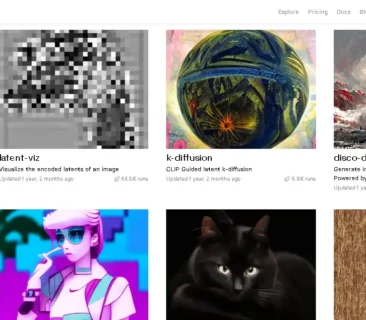Introduction:
In a world where innovation accelerates at an unprecedented pace, the advertising landscape is undergoing a profound transformation, powered by the relentless advancements in artificial intelligence. Welcome to the realm where data-driven insights, predictive analytics, and creative ingenuity converge, giving rise to a new era of advertising dynamics. In this article, we embark on a journey through the changing dynamics of advertising, unveiling the AI-driven trends and innovations that are reshaping the very fabric of this industry.
From precision personalization that speaks directly to individual preferences to the automated generation of captivating content, AI’s influence on advertising is nothing short of revolutionary. As brands and marketers strive to capture the attention of their audiences in an increasingly digital world, the fusion of technology and creativity has birthed a range of transformative strategies. But amidst this paradigm shift lies a terrain of ethical considerations and a constant need for adaptation.
Join us on NextechPulse as we dissect the captivating realm of AI-driven advertising. We’ll explore the intricate layers of personalization, delve into the mechanics of automated creativity, and navigate the powerful intersections of predictive analytics, voice search, and visual engagement. As we peer into the horizon, we’ll also examine the industry’s ethical obligations and unveil a roadmap to seamlessly integrate AI into marketing strategies.
Buckle up as we unveil the dawn of an advertising revolution where machines don’t just automate tasks, but redefine the very essence of connection and communication. The future of advertising is here, and it’s illuminated by the AI-driven innovations that we’re about to unravel.
1. AI’s Advertising Metamorphosis:
In the fast-evolving landscape of advertising, artificial intelligence has emerged as the driving force behind a transformative metamorphosis. Gone are the days of one-size-fits-all campaigns that cast wide nets and hoped for returns. With AI, a new era of precision and relevance has dawned.
At the core of this metamorphosis lies the ability of AI to decipher massive amounts of data, providing actionable insights that were once unimaginable. Machine learning algorithms analyze consumer behavior, preferences, and even emotions, offering a holistic view of the target audience. This data-driven approach enables advertisers to craft campaigns that resonate deeply with individual consumers, fostering a sense of connection and personal relevance.
Personalization Precision:
The power of AI lies in its capacity to analyze intricate patterns in user behavior, enabling hyper-personalized advertising strategies. Advertisers can now create content that speaks to consumers on a personal level, addressing their specific needs, desires, and pain points. This level of personalization not only captures attention but also cultivates brand loyalty and drives higher conversion rates.
Imagine receiving an email that suggests products tailored precisely to your recent online searches or being served ads that align with your interests and preferences. AI-powered personalization turns these scenarios into reality, enhancing the overall user experience and increasing the likelihood of engagement.
Furthermore, AI’s ability to adapt in real-time ensures that the personalization remains relevant throughout the customer journey. As user preferences shift, AI algorithms adjust the messaging and content accordingly, ensuring that every interaction feels tailored, even as circumstances change.
In essence, personalization precision fueled by AI is more than just a strategy; it’s a fundamental shift in how brands communicate and connect with their audiences. It fosters a sense of mutual understanding and empathy, transforming the consumer-brand relationship from a transactional one to a personalized and enduring connection.
The AI-driven revolution in advertising is not just about understanding consumer behavior, but predicting it. In the next section, we’ll explore how predictive analytics powered by AI are reshaping the way ads are placed and timed, optimizing engagement and returns.
2. Predictive Analytics Power:
In the ever-evolving landscape of advertising, the integration of AI-driven predictive analytics has ushered in a new era of precision and effectiveness. No longer reliant on guesswork or historical data alone, advertisers now have the tools to anticipate consumer behavior and optimize ad placement and timing for maximum impact.
Anticipating Trends, Maximizing Impact:
Predictive analytics harness the immense power of AI algorithms to analyze a myriad of data sources, from past consumer behavior and social media interactions to market trends and external factors. By identifying patterns and correlations within this data, AI can predict consumer preferences, trends, and even potential shifts in demand.
Imagine a scenario where a retail brand can accurately predict the upcoming colors and styles that will be in high demand during the next fashion season. By leveraging AI’s predictive capabilities, advertisers can align their campaigns and product offerings with these trends, maximizing their impact and relevance.
Optimizing Ad Placement and Timing:
One of the key challenges in advertising has always been determining the optimal time and platform for reaching the target audience. AI-driven predictive analytics solve this challenge by identifying the most effective times for ad placements based on user behavior patterns.
For instance, if a user tends to engage with content during their morning commute or during specific times of the day, AI can ensure that the ad is prominently displayed during those periods. This strategic approach increases the likelihood of the ad being seen and engaged with, resulting in higher conversion rates.
Enhancing Return on Investment (ROI):
Perhaps one of the most significant benefits of AI-driven predictive analytics is the enhancement of ROI. By identifying high-potential opportunities and optimizing resource allocation, advertisers can ensure that their budget is directed towards campaigns with the highest likelihood of success.
Furthermore, as predictive models continue to learn and evolve based on real-time data, the accuracy of their predictions improves over time. This iterative process enables advertisers to refine their strategies continually, enhancing their overall effectiveness and return on investment.
In the dynamic world of advertising, predictive analytics powered by AI provide a competitive edge by aligning campaigns with consumer behavior and market trends. The ability to anticipate trends and optimize ad placement and timing ensures that every ad impression counts, leading to improved engagement, conversion rates, and ultimately, business success.
3. Voice and Visual Search Synergy:
In the realm of advertising, the convergence of artificial intelligence with voice and visual search technologies is rewriting the rules of engagement. This synergy brings forth a new era of interactive, immersive, and highly intuitive advertising experiences that cater to the evolving behaviors of modern consumers.
Voice Search Unleashed:
The rise of voice-activated virtual assistants like Siri, Google Assistant, and Alexa has ushered in a new way of searching for information. In fact, by 2023, it’s estimated that nearly 50% of all online searches will be voice-based. This shift has significant implications for advertising, as brands adapt to the conversational nature of voice search.
AI-driven algorithms decipher natural language and intent, allowing advertisers to tailor their content to match the way users speak and inquire. For instance, a user searching for “best smartphones under $500” through voice might trigger an ad that not only lists relevant options but also provides spoken details about their features and benefits.
Visual Search Revolution:
Visual search takes the user experience to a whole new level by allowing users to search using images rather than text. This technology enables consumers to snap a picture of an item they’re interested in and find similar products instantly, bridging the gap between inspiration and action.
AI’s role in visual search is pivotal. It enables the analysis of visual content, recognizing patterns, shapes, colors, and even textures within images. For advertisers, this means that products displayed in images can be linked directly to purchase options, creating a seamless path from inspiration to conversion.
Imagine a user taking a picture of a pair of sneakers they spotted on the street. AI-powered visual search not only identifies the exact model but also directs the user to online stores where they can purchase the same or similar shoes.
A New Era of Engagement:
The synergy of AI with voice and visual search transforms advertising from a passive interaction to an engaging and interactive experience. Users can simply speak their inquiries or show images of what they’re looking for, and AI bridges the gap between intent and action.
This dynamic engagement allows advertisers to create immersive storytelling experiences, providing additional context and information through voice or visual overlays. Brands can forge deeper connections by responding to user inquiries in a personalized and conversational manner, fostering a sense of dialogue rather than a monologue.
As we move forward in this AI-driven age, the integration of voice and visual search into advertising strategies presents an exciting opportunity to captivate audiences through innovative and highly personalized experiences. The journey to harnessing the full potential of this synergy has just begun, promising a future where the line between advertising and user interaction becomes beautifully blurred.
4. Ethical Dimensions:
As the advertising landscape evolves with the integration of AI-driven innovations, a crucial facet that demands our attention is the ethical dimension. While AI brings unprecedented opportunities, it also poses significant ethical challenges that need to be navigated with care and responsibility.
Data Privacy and Transparency:
One of the foremost ethical considerations in AI-driven advertising is data privacy. The collection, analysis, and utilization of consumer data raise concerns about how personal information is safeguarded. Advertisers must ensure that user data is handled in compliance with privacy regulations and that users are informed about how their data will be used.
Transparency is equally paramount. Users should have clear visibility into the fact that they’re interacting with AI-generated content or conversational agents. Disclosure about automated responses, chatbots, or AI-generated content ensures that users understand the nature of their interactions, fostering trust and credibility.
Bias and Fairness:
AI algorithms learn from data, and if that data contains biases, the algorithms can inadvertently perpetuate those biases. In advertising, this can lead to discriminatory targeting or content that reinforces stereotypes. Advertisers must actively monitor and address biases in AI algorithms to ensure fairness and equal representation.
Creating diverse and inclusive training data sets is a crucial step in mitigating bias. Additionally, regular audits of AI systems can help identify and rectify any unintended biases that might emerge over time.
Impact on Employment:
The automation potential of AI in advertising has raised concerns about potential job displacement. As certain tasks become automated, there’s a need to reskill and upskill the workforce to align with the evolving roles within the industry.
Ethical responsibility lies in ensuring a smooth transition for employees whose roles might be impacted. This could involve providing training opportunities, supporting career transitions, and fostering an environment that values human creativity and strategic thinking alongside AI capabilities.
Balancing Innovation with Responsibility:
The ethical dimensions of AI in advertising highlight the need for a delicate balance between innovation and responsibility. Advertisers must continuously assess the social and cultural impacts of their AI-driven strategies, striving to create experiences that enrich users’ lives rather than exploit their vulnerabilities.
By adopting codes of ethics, adhering to industry standards, and engaging in transparent dialogues with users, advertisers can navigate the ethical terrain of AI in advertising with integrity and foresight.
In the grand tapestry of AI-driven advertising, ethics serve as the guiding thread that ensures the positive transformation of the industry. As we embrace the potential of AI, let us also embrace the responsibility to shape an advertising landscape that respects users, empowers employees, and contributes positively to society as a whole.
5. Automated Creativity:
In the ever-evolving world of advertising, the marriage of artificial intelligence and creativity is ushering in a new era of content generation and campaign development. Automated creativity, powered by AI, is reshaping how brands conceptualize, create, and deliver captivating content to their audiences.
Unleashing AI-Generated Content:
Imagine a scenario where generating high-quality ad content is not a time-consuming process that requires extensive human effort, but a task that AI can handle with remarkable efficiency. This is the promise of automated creativity. AI-driven algorithms can produce a variety of content formats, including text, images, videos, and even music.
For instance, AI can generate compelling copy for ad campaigns based on brand guidelines and target audience preferences. It can also create visuals and videos that align seamlessly with a brand’s aesthetic, saving both time and resources for creative teams.
Dynamic Ad Creation:
Dynamic ads are personalized ad units that change based on real-time data and user interactions. This level of customization and relevance is a testament to the power of automated creativity. AI algorithms analyze user behavior, demographics, and preferences, and then modify the ad content accordingly.
Augmenting Human Creativity:
Rather than replacing human creativity, AI augments it. Automated creativity tools provide a foundation upon which creative professionals can build, freeing them from repetitive tasks and enabling them to focus on strategic thinking and ideation.
By leveraging AI-generated content and dynamic ad creation, brands can maintain a consistent and relevant online presence, even in the face of rapidly changing trends and consumer preferences.
The Art-Science Convergence:
Automated creativity is a fusion of art and science. The algorithms that power content generation are based on patterns, trends, and data insights. Yet, the output they create is designed to resonate with human emotions, preferences, and cultural nuances.
As we embrace automated creativity, the challenge lies in maintaining authenticity and emotional resonance in AI-generated content. Striking the right balance between data-driven insights and human touch ensures that the content remains relatable and impactful.
In this dynamic landscape, AI’s role in automated creativity is not just about efficiency; it’s about enhancing the overall creative process and delivering content that resonates deeply with audiences.
Closing:
As we conclude our exploration into the changing dynamics of advertising propelled by AI-driven trends and innovations, it’s clear that we stand on the brink of an extraordinary era. The landscape that once relied on intuition and generalized campaigns has been replaced by a realm where precision personalization and predictive analytics reign supreme.
The fusion of data-driven insights with creative ingenuity has birthed a new way of connecting with consumers—one that transcends the conventional boundaries of advertising. AI’s ability to decipher consumer behavior and predict trends has shifted the paradigm from reactive to proactive, ensuring that brands engage with their audiences at the right time and with the right message.
Yet, with all its promise, this AI-powered journey is not without its challenges. Ethical considerations, such as data privacy and transparency, require careful navigation as we continue to integrate AI into advertising strategies. The road ahead demands adaptability, a willingness to embrace emerging technologies, and a commitment to crafting experiences that resonate deeply with consumers.
On NextechPulse, we’ve unveiled just a fraction of the immense potential that AI holds for the advertising industry. From automated creativity to the synergy of voice and visual search, every innovation opens up new avenues for creating meaningful connections between brands and their audiences.
As we look to the future, the possibilities are boundless. Augmented reality ads that blend seamlessly with the physical world, emotional resonance AI that tailors messaging based on user sentiment, and continued advancements in personalization—all these await us in the ever-evolving landscape of advertising.
Thank you for joining us on this journey through the AI-driven advertising revolution. As technology propels us forward, let us remember that while the tools may change, the heart of advertising remains the same: forging connections, telling stories, and capturing the imagination of a world that’s always hungry for the next innovation.
References:
1. D’Mello, C. (2022). AI and Personalization in Advertising: Benefits and Challenges. AdAge.
2. O’Connor, S. (2023). How Predictive Analytics Is Transforming Digital Advertising. Forbes.
3. Sheppard, S. (2023). The Synergy of Voice and Visual Search: What It Means for Marketers. Search Engine Journal.
4. Waber, B. (2021). The Ethical Challenges of AI in Advertising. Harvard Business Review.
5. Cunningham, C. (2022). How AI Is Transforming Creativity in Advertising. Adweek.




